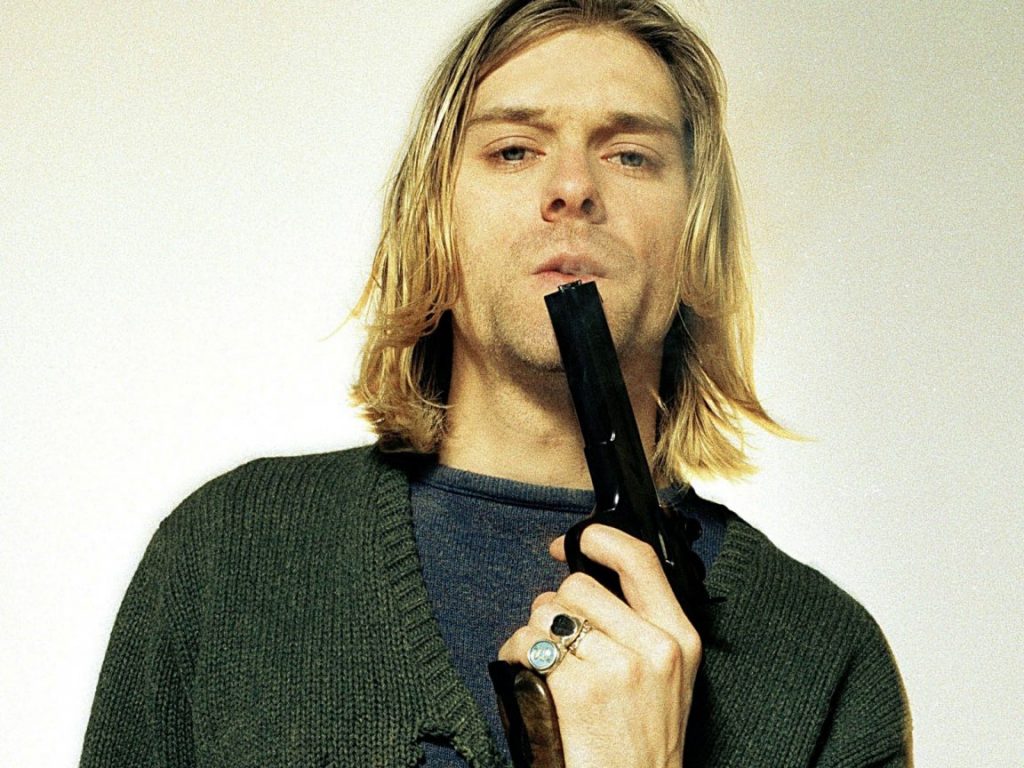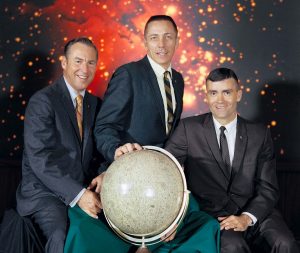“I’m not afraid of dying. Total peace after death, becoming someone else is the best hope I’ve got.” This statement made by Nirvana front-man Kurt Cobain reflects both the self-loathing and general sorrow, or anguish, that he felt he was constantly suffering from and ultimately what led to the tragic event that occurred on April 5, 1994. Kurt Cobain, the lead singer of the band Nirvana, was born in Hoaquiam, Washington on February 20, 1967.1 Few honestly know of the struggles Kurt had to endure in his life, such as his parents’ divorce when he was about nine. This break-up resulted in Kurt losing a permanent place of residence, leaving him in a constant state of borderline homelessness. As a matter of fact, Kurt even resorted to staying at the hospital where he was born around the age of nineteen.2 Regardless, Kurt still managed to climb from rock bottom to become the star he was: the lead singer of Nirvana and the face of grunge music for many people worldwide.

Of course, Nirvana didn’t come straight out the gate making hits nor score international shows. The band Nirvana actually had quite a macabre or fuzzy rise in comparison to other bands. Interestingly enough, Nirvana didn’t even start off being called Nirvana. This small trio actually bounced around with abstract names for quite a few years. From their humble beginnings in Aberdeen, Washington, in 1987 the band was known as Skid Row, Pen Cap Chew, and Bliss all within the same year.3 They played a few house parties and even fewer shows at real venues around the Aberdeen area, but the band life was more of a hobby to the group. They had fun doing what they did, played their hearts out when they had to, but they didn’t really think they were going to be anything huge when they first started out.
The group may have started small, but the effort and time they put into the band would soon enough pay off. In 1989, they released their independent album Bleach, which got them a lot more shows in lots of new places. The band finally started “blowing up” and gathering many followers nationwide. With this newfound momentum, Nirvana signed with Geffen Records and released their second album Nevermind, which has since become legendary. This was just two years after their first independent album Bleach was released.4 Nevermind kicked off Nirvana’s international rise to a new high, scoring them not only shows around the country, but in other countries as well. Nirvana went global and this new, dissonant, and muddy type of rock music started receiving mainstream recognition. This new and quickly popular genre became known and recognized as grunge, a form of punk rock with the muddy sounds of post-punk mixed with a sprinkle of youthful angst.5 This new genre became the sound of the ’90’s, with many bands such as Soundgarden, Pearl Jam, and Alice in Chains riding the wave. But for many worldwide, songs such as “Smells Like Teen Spirit” or most of the songs from Nirvana’s Nevermind album became grunge anthems that depicted the youthful rebellion and dissonance reflected in grunge music.6

Although Nirvana was finally blowing up and rising to international fame quickly, the lead singer Kurt Cobain was still not truly satisfied with his life. Throughout his life, Cobain constantly suffered from stomach illnesses. In response to this constant illness, Kobain would abuse drugs like heroin, claiming it would cure this problem. Even worse, when Kurt met his soon to be mother of his child Kourtney Love, his heroin abuse only got worse.7 With more money and fame, his addiction grew stronger and the pressures of fame and fortune began mounting on his shoulders, until one day it was just too much. In 1994, while on tour in Europe, Kurt had to be hospitalized for drug overdose and other health issues including alcohol problems. Soon after, he was forced to cancel the tour and return back home to Seattle. His family and friends decided to stage an intervention and convince him to admit himself into rehab, much to his displeasure. This rehabilitation did not last long, as Kurt decided to flee the rehab center and return back home to Seattle, tragically unbeknownst to his family and friends. On April 8, 1994, an electrician found Kurt Cobain’s dead body in a room above the garage above his home where he was hiding out at.8 The cause of death was a self-inflicted shotgun blast to the head, and even worse, heroin was found in his system so it’s not even clear if Cobain really meant to do that to himself or if the drugs influenced him to do so.9
Cobain’s inconceivable and unanticipated death resulted in worldwide mourning over the loss of this young artist’s life. Family and friends, especially his girlfriend and daughter, were heavily affected by this tragedy, as well as all of his listeners. Cobain was an icon for Generation X. He gave voice to the youthful generation of people that felt they were dealt a bad hand. He encouraged the generation, and became “the poster boy for grunge.” After Kurt’s death, the grunge scene died down quickly. Of course, there were still other bands in the genre putting out a few successful albums, but the genre never saw the fame and glory it had during its heyday in the early ’90’s, when Nirvana was contributing to the movement.10 The genre died out as quickly as it was born, with the untimely and very unfortunate death of a very talented and tormented young artist.
- Salem Press Biographical Encyclopedia, 2013, s.v. “Kurt Cobain,” by Delbert S. Bowers. ↵
- Nick Soulsby, I Found My Friends: The Oral History of Nirvana (New York : Thomas Dunne Books/St. Martin’s Griffin, 2015). 7. ↵
- Salem Press Encyclopedia, 2013, s.v. “Nirvana (music),” by Alan Haslam; Nick Soulsby, I Found My Friends: The Oral History of Nirvana (New York : Thomas Dunne Books/St. Martin’s Griffin, 2015), 1-18. ↵
- Salem Press Encyclopedia, 2013, s.v. “Nirvana (music),” by Alan Haslam. ↵
- Baker’s Biographical Dictionary of Popular Musicians, 2004, s.v. “Grunge: A Brief History of a Hard Rock Genre,” by Gil Kaufman. ↵
- Baker’s Biographical Dictionary of Popular Musicians, 2004, s.v. “Grunge: A Brief History of a Hard Rock Genre,” by Gil Kaufman. ↵
- Salem Press Biographical Encyclopedia, 2013, s.v. “Kurt Cobain,” by Delbert S. Bowers. ↵
- Salem Press Biographical Encyclopedia, 2013, s.v. “Kurt Cobain,” by Delbert S. Bowers. ↵
- Salem Press Encyclopedia, 2013, s.v. “Nirvana (music),” by Alan Haslam. ↵
- Baker’s Biographical Dictionary of Popular Musicians, 2004, s.v. “Grunge: A Brief History of a Hard Rock Genre,” by Gil Kaufman. ↵



112 comments
Yuliana Vasquez
Its a surprise to know how they actually begun, to know that their band was only a hobby and for them to never think they would become big is pretty interesting. I also didn’t know the cause of death and it’s such a sad thing to read because for him to be under the influence and not know if he actually wanted to do it, that’s intense. This honestly caught my eye because I wanted to know information about him.
Micheal Baladez
Although I had only listened to two of Nirvana’s songs,these being Heart-shaped Box and Smells like Teen spirit, I knew a lot about the troubled life of Kurt Cobain; I knew about his Heroin addiction,I knew about his attempts at rehabilitation, however, I never knew about the band’s earliest performances before there was a Nirvana alongside the life of Kurt Cobain before and while he was a star. The brief summary this article gives to these events, without skipping the major details, serves as a great way to shine light upon the earlier years of the band and its subsequent rise and hard fall. Although a great tragedy in its own right, the death of Kurt Cobain can be seen as a catalyst for many individuals to go against drugs and the abuse of them.
Mike B.
Although I had only listened to two of Nirvana’s songs,these being Heart-shaped Box and Smells like Teen spirit, I knew a lot about the troubled life of Kurt Cobain; I knew about his Heroin addiction,I knew about his attempts at rehabilitation, however, I never knew about the band’s earliest performances before there was a Nirvana alongside the life of Kurt Cobain before and while he was a star. The brief summary this article gives to these events, without skipping the major details, serves as a great way to shine light upon the earlier years of the band and its subsequent rise and hard fall. Although a great tragedy in its own right, the death of Kurt Cobain can be seen as a catalyst for many individuals to go against drugs and the abuse of them.
Melissa Garza
Great article Kailan! I absolutely love Nirvana and their music. I was unaware of how much trouble the lead singer Kurt Cobain went through growing up. Being borderline homeless after his parents split up must have really influenced him to get more power than what he had in the situation. And in the end, money is ultimately power. I was wondering if you’ve looked in to the conspiracy theory of his death being a murder instead of a suicide? It is quite interesting and think you’d find some crazy information.
Vanessa Quetzeri
I have heard of the band Nirvana and infamous Kurt Cobain. I, however, did not know that he was dealing with a stomach illness or that he was abusing heroin to ease the pain. I think it is impressive how he went from being homeless to a worldwide sensation as quick as he did. It is very sad to read that Kurt Cobain killed himself, whether it was intentional or not.
Nicholas Hatch
This article was very interesting. Although I have never been a fan of the band Nirvana, I know there are a lot of people who are fans of this band. It was very sad to hear about Kurt’s death. Saddening to hear that he was not satisfied with his own life so he turned to drugs as an escape from reality. One thing I didn’t know about the band was that they changed their name three different times. Overall, this article was very informing and well-written.
Victoria Davis
I always see many people wearing a shirt with Nirvana, but never knew what it stood for. After reading this article I really enjoyed the music. It’s such a loss to the music industry that he decided to take his own life. Although his mental health was a problem for him, he did leave a legacy behind. He was such talent as a singer and song writer.
Saira Locke
Growing up I never really heard of Nirvana at all. Reading and listing to his music taught me how great of a artist and person he really was. Mental health is something very serious and is hard to overcome. Nirvana wasn’t pleased with his life and decided to take his own life sadly. He was such a talented song writer and singer.
Thalia Romo
As I was growing up, I grew fond of Nirvana’s sound and the style of music they had. Eventually when I did a little more research of my own I found out that Kurt Cobain eventually committed suicide due to mental health problems. Nonetheless, he managed to leave a legacy behind his name and the band. The grunge genre is a very intriguing one that many enjoy now. This article did a great job at speaking of the bands upcoming, from small town band to world-wide. Rest in peace Kurt.
Amanda Uribe
I have never really known too much about Nirvana. However, reading about how many struggles Kurt’s dealt with was sad. From family issues to drug problems. It is sad when people become addicted to drugs. I didn’t know that he used drugs to help his stomach problems. I know that Kurt will always live on through his music.